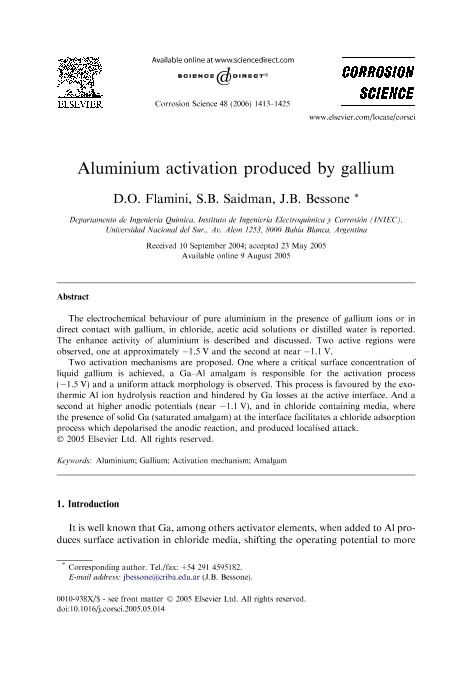Mostrar el registro sencillo del ítem
dc.contributor.author
Flamini, Daniel Omar

dc.contributor.author
Saidman, Silvana Beatriz

dc.contributor.author
Bessone, Jorge Bartolome

dc.date.available
2019-08-27T17:12:59Z
dc.date.issued
2006-06
dc.identifier.citation
Flamini, Daniel Omar; Saidman, Silvana Beatriz; Bessone, Jorge Bartolome; Aluminium activation produced by gallium; Pergamon-Elsevier Science Ltd; Corrosion Science; 48; 6; 6-2006; 1413-1425
dc.identifier.issn
0010-938X
dc.identifier.uri
http://hdl.handle.net/11336/82248
dc.description.abstract
The electrochemical behaviour of pure aluminium in the presence of gallium ions or in direct contact with gallium, in chloride, acetic acid solutions or distilled water is reported. The enhance activity of aluminium is described and discussed. Two active regions were observed, one at approximately -1.5 V and the second at near -1.1 V. Two activation mechanisms are proposed. One where a critical surface concentration of liquid gallium is achieved, a Ga-Al amalgam is responsible for the activation process (-1.5 V) and a uniform attack morphology is observed. This process is favoured by the exothermic Al ion hydrolysis reaction and hindered by Ga losses at the active interface. And a second at higher anodic potentials (near -1.1 V), and in chloride containing media, where the presence of solid Ga (saturated amalgam) at the interface facilitates a chloride adsorption process which depolarised the anodic reaction, and produced localised attack.
dc.format
application/pdf
dc.language.iso
eng
dc.publisher
Pergamon-Elsevier Science Ltd

dc.rights
info:eu-repo/semantics/openAccess
dc.rights.uri
https://creativecommons.org/licenses/by-nc-sa/2.5/ar/
dc.subject
Activation Mechanism
dc.subject
Aluminium
dc.subject
Amalgam
dc.subject
Gallium
dc.subject.classification
Físico-Química, Ciencia de los Polímeros, Electroquímica

dc.subject.classification
Ciencias Químicas

dc.subject.classification
CIENCIAS NATURALES Y EXACTAS

dc.title
Aluminium activation produced by gallium
dc.type
info:eu-repo/semantics/article
dc.type
info:ar-repo/semantics/artículo
dc.type
info:eu-repo/semantics/publishedVersion
dc.date.updated
2019-08-16T15:44:37Z
dc.journal.volume
48
dc.journal.number
6
dc.journal.pagination
1413-1425
dc.journal.pais
Países Bajos

dc.journal.ciudad
Amsterdam
dc.description.fil
Fil: Flamini, Daniel Omar. Universidad Nacional del Sur. Departamento de Ingeniería Química; Argentina. Consejo Nacional de Investigaciones Científicas y Técnicas. Centro Científico Tecnológico Conicet - Bahía Blanca; Argentina
dc.description.fil
Fil: Saidman, Silvana Beatriz. Universidad Nacional del Sur. Departamento de Ingeniería Química; Argentina. Consejo Nacional de Investigaciones Científicas y Técnicas. Centro Científico Tecnológico Conicet - Bahía Blanca; Argentina
dc.description.fil
Fil: Bessone, Jorge Bartolome. Universidad Nacional del Sur. Departamento de Ingeniería Química; Argentina. Consejo Nacional de Investigaciones Científicas y Técnicas. Centro Científico Tecnológico Conicet - Bahía Blanca; Argentina
dc.journal.title
Corrosion Science

dc.relation.alternativeid
info:eu-repo/semantics/altIdentifier/url/https://www.sciencedirect.com/science/article/pii/S0010938X0500154X
dc.relation.alternativeid
info:eu-repo/semantics/altIdentifier/doi/http://dx.doi.org/10.1016/j.corsci.2005.05.014
Archivos asociados
